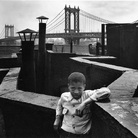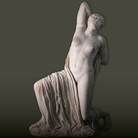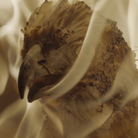Warhol inedito: le prime sperimentazioni digitali con Amiga. Una mostra documentario a Milano

Andy Warhol, Autoritratto, 1985, Amiga 1000
Dal 21 October 2015 al 21 November 2015
Milano
Luogo: Deodato Arte
Indirizzo: via Santa Marta 6
Orari: martedì - sabato 10.30-14 / 15-19
Telefono per informazioni: +39 02 39521618
E-Mail info: galleria@deodato-arte.it
Sito ufficiale: http://www.deodato.com
Un corpus di opere inedite di Warhol per la prima volta in Italia da Deodato Arte.
L’esposizione celebra i trent’anni della presentazione di Amiga 1000 al Lincoln Center di New York e ricrea il contesto originale nel quale l’artista inizia a sperimentare la digital art e se ne appassiona.
Con questo importante appuntamento la galleria Deodato Arte apre la sua nuova sede nella centralissima via Santa Marta a Milano.
In mostra sono esposti due storici pc Amiga 1000 del 1985 in cui si ammirano 9 opere inedite elaborate da Warhol, 16 acetati di cui 6 inediti, provenienti dalla serie Ladies and Gentleman, che ritraggono personalità frequentate da Warhol, modelle e drag queen, ingaggiate per il progetto, serigrafie, dischi, banconote da 2 dollari e da 100.000 lire, oltre a una ricca documentazione che include fotografie, filmati, la rivista “Amiga Word” con l’intervista all’icona della Pop Art, alcuni numeri del mensile “Interview” e biglietti di Leo Castelli.
Affianca l’esposizione un omaggio del fotografo, stampatore e artista Giuliano Grittini, noto per le sue collaborazioni con molti artisti tra cui Warhol, del quale per questa occasione ha stampato e rielaborato a tecnica mista 10 opere digitali.
Il 23 luglio 1985 Commodore lancia l’Amiga 1000, il primo personal computer multimediale, e per il grande evento invita Andy Warhol a realizzare un’opera al Vivian Beaumont Theater: per l’occasione viene scattata a Debbie Harry, cantante leader del gruppo Blondie una foto in bianco e nero da una fotocamera collegata a un computer - una tecnologia rivoluzionaria per l’epoca - e l’artista interviene con rielaborazioni cromatiche, che danno vita alla prima opera di computer-art firmata Warhol.
Da questo momento fino alla sua scomparsa (1987), sperimenta con grande entusiasmo le potenzialità del rivoluzionario mezzo, acquistando una batteria di Amiga e realizzando numerose rielaborazioni delle sue opere, fra cui il barattolo della zuppa Campbell, la banana della copertina del disco dei Velvet Underground, il ritratto di Marilyn Monroe e molte altre, che costituiscono ad oggi un inesplorato patrimonio.
L’interesse di Warhol per questo linguaggio viene esaustivamente espresso nell’intervista del 1986 pubblicata su “Amiga Word”, dove alla domanda What are the things that you like the most about doing this kind of art on the Amiga? Warhol risponde Well, I like it because it looks like my work,che sottolinea lo stretto legame nato con una tecnologia estremamente innovativa per l’epoca, ma soprattutto vicina alla sua personale espressione artistica.
Dal 1987, questo corpus di lavori viene temporaneamente dimenticato e solo a seguito di un lungo processo di recupero dei dati, di difficile decriptazione, si arriva a restituirne i contenuti in parte presenti eccezionalmente in mostra.
L’esposizione celebra i trent’anni della presentazione di Amiga 1000 al Lincoln Center di New York e ricrea il contesto originale nel quale l’artista inizia a sperimentare la digital art e se ne appassiona.
Con questo importante appuntamento la galleria Deodato Arte apre la sua nuova sede nella centralissima via Santa Marta a Milano.
In mostra sono esposti due storici pc Amiga 1000 del 1985 in cui si ammirano 9 opere inedite elaborate da Warhol, 16 acetati di cui 6 inediti, provenienti dalla serie Ladies and Gentleman, che ritraggono personalità frequentate da Warhol, modelle e drag queen, ingaggiate per il progetto, serigrafie, dischi, banconote da 2 dollari e da 100.000 lire, oltre a una ricca documentazione che include fotografie, filmati, la rivista “Amiga Word” con l’intervista all’icona della Pop Art, alcuni numeri del mensile “Interview” e biglietti di Leo Castelli.
Affianca l’esposizione un omaggio del fotografo, stampatore e artista Giuliano Grittini, noto per le sue collaborazioni con molti artisti tra cui Warhol, del quale per questa occasione ha stampato e rielaborato a tecnica mista 10 opere digitali.
Il 23 luglio 1985 Commodore lancia l’Amiga 1000, il primo personal computer multimediale, e per il grande evento invita Andy Warhol a realizzare un’opera al Vivian Beaumont Theater: per l’occasione viene scattata a Debbie Harry, cantante leader del gruppo Blondie una foto in bianco e nero da una fotocamera collegata a un computer - una tecnologia rivoluzionaria per l’epoca - e l’artista interviene con rielaborazioni cromatiche, che danno vita alla prima opera di computer-art firmata Warhol.
Da questo momento fino alla sua scomparsa (1987), sperimenta con grande entusiasmo le potenzialità del rivoluzionario mezzo, acquistando una batteria di Amiga e realizzando numerose rielaborazioni delle sue opere, fra cui il barattolo della zuppa Campbell, la banana della copertina del disco dei Velvet Underground, il ritratto di Marilyn Monroe e molte altre, che costituiscono ad oggi un inesplorato patrimonio.
L’interesse di Warhol per questo linguaggio viene esaustivamente espresso nell’intervista del 1986 pubblicata su “Amiga Word”, dove alla domanda What are the things that you like the most about doing this kind of art on the Amiga? Warhol risponde Well, I like it because it looks like my work,che sottolinea lo stretto legame nato con una tecnologia estremamente innovativa per l’epoca, ma soprattutto vicina alla sua personale espressione artistica.
Dal 1987, questo corpus di lavori viene temporaneamente dimenticato e solo a seguito di un lungo processo di recupero dei dati, di difficile decriptazione, si arriva a restituirne i contenuti in parte presenti eccezionalmente in mostra.
SCARICA IL COMUNICATO IN PDF
COMMENTI

-
 Dal 2 December 2025 al 19 February 2026
Milano | Centro Culturale di Milano
Dal 2 December 2025 al 19 February 2026
Milano | Centro Culturale di Milano
Walter Rosenblum. Il mondo e la tenerezza
-
 Dal 30 November 2025 al 12 April 2026
Gallarate | Museo MA*GA
Dal 30 November 2025 al 12 April 2026
Gallarate | Museo MA*GA
Kandinsky e l’Italia
-
 Dal 29 November 2025 al 12 April 2026
Roma | Musei Capitolini
Dal 29 November 2025 al 12 April 2026
Roma | Musei Capitolini
La Grecia a Roma
-
 Dal 22 November 2025 al 3 May 2026
Torino | Sale Chiablese dei Musei Reali
Dal 22 November 2025 al 3 May 2026
Torino | Sale Chiablese dei Musei Reali
Orazio Gentileschi. Un pittore in viaggio
-
 Dal 20 November 2025 al 25 January 2026
Firenze | Palazzo Strozzi
Dal 20 November 2025 al 25 January 2026
Firenze | Palazzo Strozzi
Andro Eradze. Bones of Tomorrow
-
 Dal 21 November 2025 al 28 March 2026
Cuneo | Complesso Monumentale di San Francesco
Dal 21 November 2025 al 28 March 2026
Cuneo | Complesso Monumentale di San Francesco
La Galleria Borghese. Da Raffaello a Bernini. Storia di una collezione


